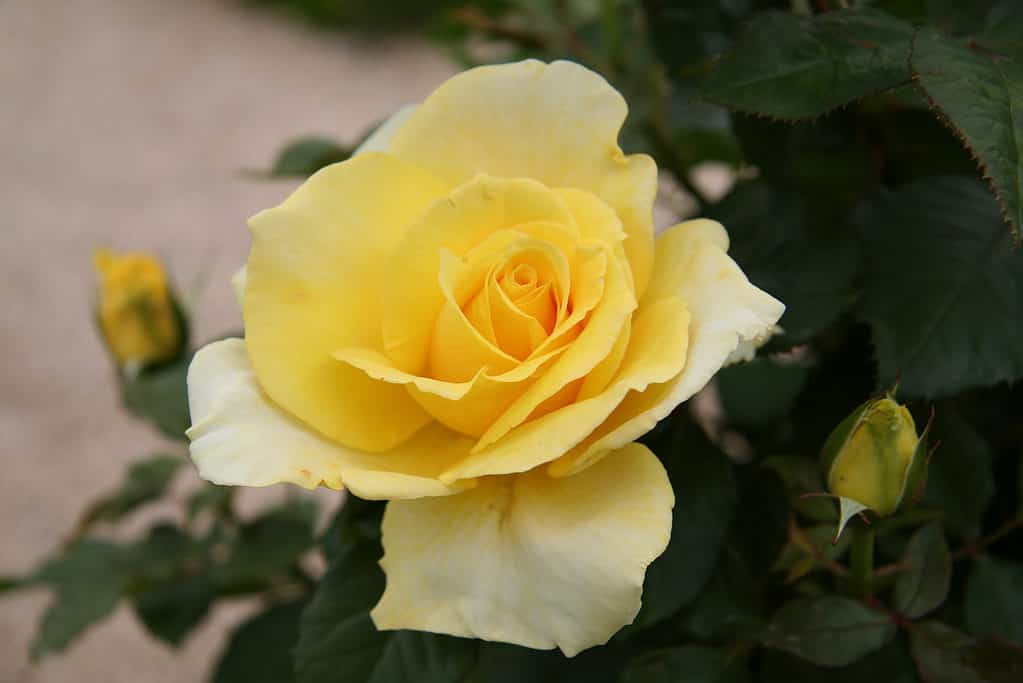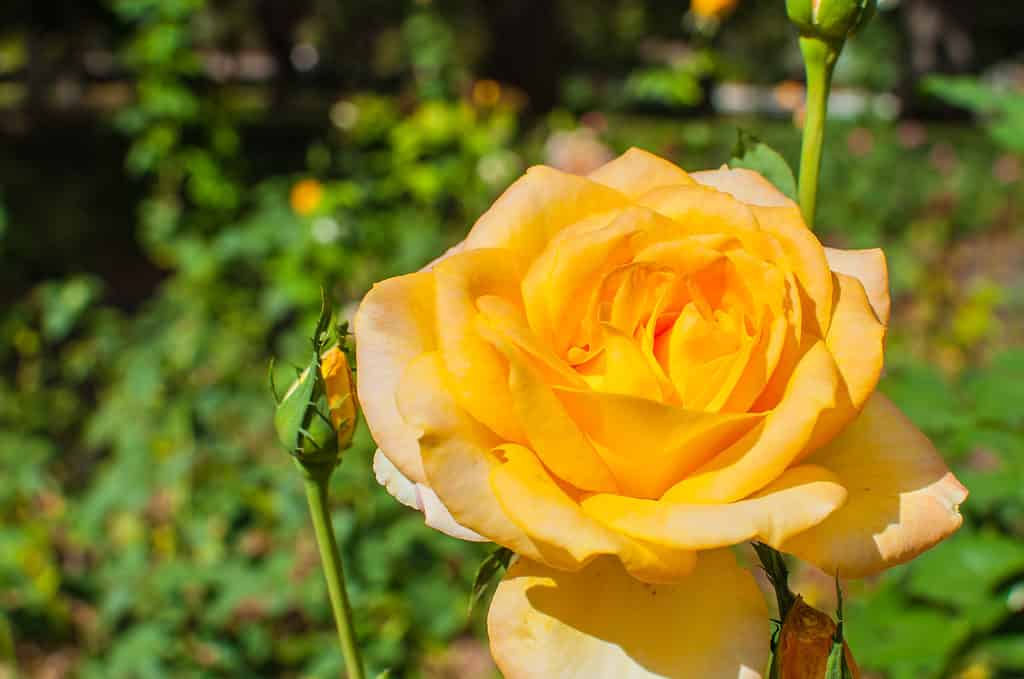If you want to grow roses in your Delaware garden and are wondering which cultivars are right for you, you’re in luck. There are more than 300 species of roses and thousands of cultivars that have been bred over hundreds of years, and there are many that are well-suited to Delaware’s temperate climate. With a rich history that spans the world, the rose is a popular topic of discussion virtually everywhere, and information on cultivating them is widely available.
Roses: A Brief History
Your garden-variety rose mostly likely has a complicated pedigree. All cultivated roses belong to the Rosaceae family, genus Rosa. Records show that the cultivation of roses began as far back as 5,000 years ago in China, where botanists estimate the genus originated. By way of natural seed dispersion, extensive trade, and interactions between civilizations, the popularity of roses spread westward into the Middle East and continued into Europe during the Roman era. Native species were grown in gardens throughout these regions for millennia until, in the late eighteenth century, distinct, domesticated cultivars made their way to Europe from China.
From there, the family tree branches out dramatically as wild species of roses, such as Rosa multiflora and Rosa rugosa, were selected for specific traits and crossed with these cultivars, leading to many classes of roses that have been interbred across the world over centuries.
Below, we will introduce you to four modern rose cultivars and talk a little bit about their classes and why you should choose them if you’re interested in growing roses in Delaware.
How Do Roses Fare in Delaware?
The state of Delaware can be divided into two main geographical regions. The coastal plain, the largest of the two and makes up 95% of the state’s total land mass, is comprised mainly of sandy, well-drained soils but also contains swampy areas of higher clay content. The small remainder of the state, the piedmont, is located in the northernmost corner and tends to have loamier soil content, endowed by its residence in the rolling foothills of Appalachia.
Roses are adaptable plants but prefer to grow in full sun, in fertile, loamy, well-draining, and slightly acidic to neutral soils. Some cultivars can handle greater alkalinity and lower levels of sunlight, while others are quite a bit more finicky. Wild species of roses tend to have more specific growing conditions but tend to be much hardier overall.
If you live in a sandier area of the coastal plain region of the state, you may need to amend your soil to retain moisture and nutrients better to grow roses that have been bred for the garden. Overly sandy soils drain water too quickly for rose roots to take in and likely lack nutrients and minerals essential to your plant’s health. Generally, roses will thrive in USDA zones 5-8, so being in Delaware’s zone 7 affords you many options to fill out your garden.
4 Rose Cultivars for Your Delaware Garden
You could choose from many cultivars from each rose class for your garden. Below, we have provided four eye-catching rose cultivars suited to USDA zone 7.
Rosa ‘Alpine Sunset’ Hybrid Tea Class

The ‘Alpine Sunset’ rose is covered in thorns that run the entire length of the upright stems.
©Spring_summer/Shutterstock.com
This cultivar features large, 4-5 inch peachy blooms with creamy to light apricot-colored margins. These fragrant, showy, cup-shaped flowers appear in the spring and will continue on and off through the summer and early fall.
The plant itself is covered in thorns that run the entire length of the upright stems, tending to reach mature heights of 2-3 feet and having a similar outward spread. They tolerate a wide range of soil pH, from moderately acidic (5.6-6.0) to slightly alkaline (7.4-7.8). Keeping these plants in full sun is important to prevent powder mildew from forming on the leaves.
‘Alpine Sunset’ belongs to the hybrid tea class of roses, the first of which was bred in France in the mid-1800s by crossing old-world roses with perpetually flowering roses. These hybrid roses express color ranges about midway between their parent cultivars. They are usually grown in gardens with the intent to use their blooms for cut flowers, as these hybrids only produce a single flower at the end of each stem.
Rosa ‘Oranges ‘n’ Lemons’ Shrub Rose Class

‘Oranges ‘n’ Lemons’ shrub rose will generally reach heights and widths of 4-5 feet.
©Jay_02/Shutterstock.com
Named for the color range of its blooms, this shrub rose produces small clusters of bright orange flowers that feature stripes and patches of yellow. Being a modern garden rose, this cultivar will produce blooms beginning in the spring and continue through late summer and early fall. Although these flowers are packed with petals and vividly colored, they tend to have a milder scent than other cultivars.
The plant will generally reach heights and widths of 4-5 feet, with stems entirely covered in thorns. Its growth habit gives it a bushier appearance than some other members of the shrub rose class, including tall climbing roses and groundcover cultivars. Like most other roses, this one can tolerate a range of soil pH, from moderately acidic to slightly alkaline.
If you frequently deal with salt spray in your yard, hardy shrub roses will be an excellent addition to your garden. Shrub rose cultivars of the species Rosa rugosa tend to have a naturally high tolerance to salts, as the species is native to beach dunes across eastern Asia.
Rosa ‘Aperitif’ Floribunda Class

Floribunda roses are significantly less picky about water and fertilizer schedules than hybrid tea roses.
©Georges Seguin (Okki) | CC BY-SA – License
Producing smaller flowers, as is typical of a floribunda rose, Rosa ‘Aperitif’ tends to fill out continuously throughout the late spring and summer with clusters of dense, 2-3-inch high-centered pink blooms with blends of yellow in the middle. This cultivar will grow to a height ranging from 3-4 feet.
Floribunda roses are hardy varieties created via the crossing of the hybrid tea roses with the polyanthas, a variety of roses cultivated directly from wild species in the late 1800s. This lineage of the floribundas gives them their natural resistance to disease and carefree nature regarding their soil conditions, in addition to their ability to bloom repeatedly. They are significantly less picky about water and fertilizer schedules than the hybrid tea roses. Some cultivars in the floribunda class, such as Marie Pavie, are even hardy down to USDA zone 5.
Rosa ‘Gold Medal’ Grandiflora Class

‘Gold Medal’ grandiflora roses retain their ability to flower continuously.
©Sarawut Konganantdech/Shutterstock.com
The plants of this grandiflora cultivar produce their large, vibrant yellow, high-centered blooms in clusters atop their lengthy stems. Growing between 4-6 feet tall on average and producing mildly-fragranced blooms up to 5 inches in diameter throughout the summer, these bushes can lend a striking appearance to the background of your garden. This particular cultivar is thornless, or nearly so, which can be helpful to the gardener when it comes time to prune. This is an especially nice trait when cutting flowers and reaching over smaller plants into bushes planted in the background.
The grandiflora class of roses is modern, first created in 1954 as crosses of floribunda roses and hybrid teas. Because of this lineage, they tend to be taller and larger-bloomed than floribundas but shorter and more densely flowered than the hybrid teas. They also retain their ability to flower continuously, a trait handed down from their distant perpetual rose ancestors, as well as their floribunda hardiness and resistance to pests and disease when cared for properly.
Common Problems with Roses in Delaware
No matter which rose cultivar you choose, some care must be taken to ensure your plant thrives. It is best practice to plant roses in sunny locations to avoid fungal infections such as powder mildew and blackspot. The extra warmth from the sun ensures that leaves stay dry. The build-up of moisture on leaf surfaces provides the ideal humid environment for fungal spores to germinate and infect the plant. You should avoid wetting flowers and foliage when watering your plants for the same reason. Be careful when using fungicidal sprays, as some cultivars are especially sensitive to them and can be damaged.
Rose rosette disease is another prominent issue in Delaware and surrounding states. This infection is caused by the rose rosette virus and is spread by tiny eriophyid mites, which invade the leaf axils and flower buds and are only visible under magnification. Symptoms of infection include excessive thorn production, abnormal red coloration of new growth, and distorted shape of flower buds. Suppose these eriophyid mites are discovered on your plant. In that case, the most effective elimination method is to assume that the plant now carries the virus and carefully dispose of the infected specimen to prevent spread.
Up Next
- 11 Types of Groundcover Roses for Landscaping
- Are Roses Toxic to Cats?
- Carnations vs. Roses: Which Flower is Better?
The photo featured at the top of this post is © Sergey Mironov/Shutterstock.com
Thank you for reading! Have some feedback for us? Contact the AZ Animals editorial team.






